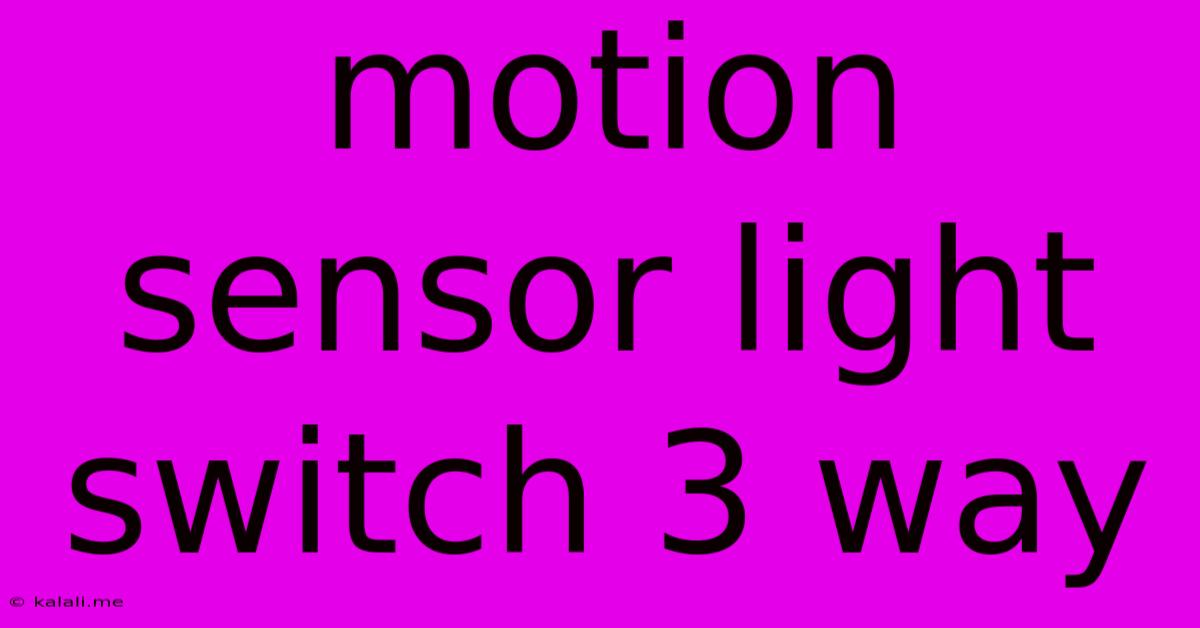Motion Sensor Light Switch 3 Way
Kalali
Jun 08, 2025 · 4 min read

Table of Contents
Illuminating the Path: A Comprehensive Guide to 3-Way Motion Sensor Light Switches
Meta Description: Confused about installing a motion sensor light switch in a 3-way setup? This guide breaks down the process, explaining the benefits, considerations, and step-by-step installation instructions for seamless lighting control.
Smart homes are all the rage, and a key component of a truly smart home is intelligent lighting. While simple motion sensor switches are easy to install, adding them to a 3-way switching system presents a slightly more complex challenge. This guide will walk you through everything you need to know about installing and utilizing a 3-way motion sensor light switch, illuminating the path to a more convenient and energy-efficient home.
Understanding 3-Way Switching
Before diving into motion sensors, let's quickly review 3-way switching. This setup allows you to control a single light fixture from two different locations. Imagine a hallway with light switches at both ends – that's a classic example of a 3-way circuit. It requires two 3-way switches and special wiring. Understanding this fundamental is crucial before adding the motion-sensing element.
Benefits of Using a 3-Way Motion Sensor Light Switch
Combining motion sensing with 3-way switching offers a wealth of advantages:
- Enhanced Convenience: Control your lights from multiple locations and automatically with motion detection. This is especially useful in long hallways, staircases, or rooms with multiple entry points.
- Improved Energy Efficiency: Lights only turn on when needed, reducing energy waste associated with forgetting to switch off lights.
- Enhanced Security: Motion detection acts as a deterrent, and automatically illuminated areas can improve nighttime visibility and security.
- Modernized Aesthetics: Integrating smart technology elevates the look and feel of your home, enhancing its overall appeal.
Types of 3-Way Motion Sensor Switches
There isn't a single "3-way motion sensor switch." Instead, you have a few options to achieve this functionality:
- Using a standard 3-way switch with a separate motion sensor: This is a more DIY-friendly approach, involving a regular 3-way switch plus a standalone motion sensor wired into the circuit. While cost-effective, this setup may require more complex wiring.
- Smart Home Hub Integration: Many smart home systems allow you to incorporate regular 3-way switches with smart bulbs or plugs that have built-in motion sensors. This provides excellent control via an app but may demand a higher initial investment.
- Dedicated 3-Way Motion Sensor Switch (Advanced): Some manufacturers offer switches specifically designed for 3-way configurations that combine both functions in one unit. These are typically more expensive but offer a cleaner, more integrated solution.
Installation Considerations
Installing a 3-way motion sensor switch requires electrical knowledge and familiarity with wiring. If you are not comfortable working with electricity, consult a qualified electrician. Safety should always be your top priority.
Key things to consider:
- Wiring Diagram: Carefully examine your existing wiring before beginning. Incorrect wiring can damage your components or even cause electrical hazards. A clear understanding of how your 3-way switches are currently wired is paramount.
- Neutral Wire: Most modern motion sensor switches require a neutral wire for power. Ensure your electrical box provides one; otherwise, you might need to upgrade your wiring.
- Load Capacity: Check the switch's specifications to make sure it can handle the wattage of your light fixture(s).
- Sensor Range and Sensitivity: Consider the range and sensitivity settings of the motion sensor to optimize performance for your specific space.
Step-by-Step Installation (Illustrative, Consult Professional Guidance)
This section provides a general overview and should not be considered a substitute for professional installation instructions. Always refer to the manufacturer's instructions for your specific product.
- Turn off power: This is the most crucial step. Turn off the power to the circuit at the breaker box.
- Remove existing switches: Carefully remove the existing 3-way switches, taking note of the wiring configuration.
- Wire the new switch(es): Connect the wires according to the wiring diagram provided with your specific switch and taking careful note of your previous wiring arrangement.
- Mount the switch(es): Securely mount the new switch(es) in the electrical boxes.
- Test the switch(es): Turn the power back on and thoroughly test the functionality of the new 3-way motion sensor switch.
Troubleshooting and FAQs
If your new switch isn't working correctly, check the following:
- Power: Ensure the power is correctly switched on at the breaker box.
- Wiring: Double-check all wire connections.
- Sensor Settings: Adjust the sensor's range and sensitivity settings.
- Switch Settings: Review the specific settings and options of the motion sensor switch itself.
By carefully considering the above information and consulting a qualified professional if needed, you can successfully install a 3-way motion sensor light switch, improving your home's safety, convenience, and energy efficiency. Remember, safety first!
Latest Posts
Latest Posts
-
Negation Often Symbolizes The Natural Language Word
Jun 08, 2025
-
What Is Bigger Than A Universe
Jun 08, 2025
-
What Are The Vials In Fallout
Jun 08, 2025
-
How Long Is Sangria Good For
Jun 08, 2025
-
How To Get Small Dent Out Of Car
Jun 08, 2025
Related Post
Thank you for visiting our website which covers about Motion Sensor Light Switch 3 Way . We hope the information provided has been useful to you. Feel free to contact us if you have any questions or need further assistance. See you next time and don't miss to bookmark.